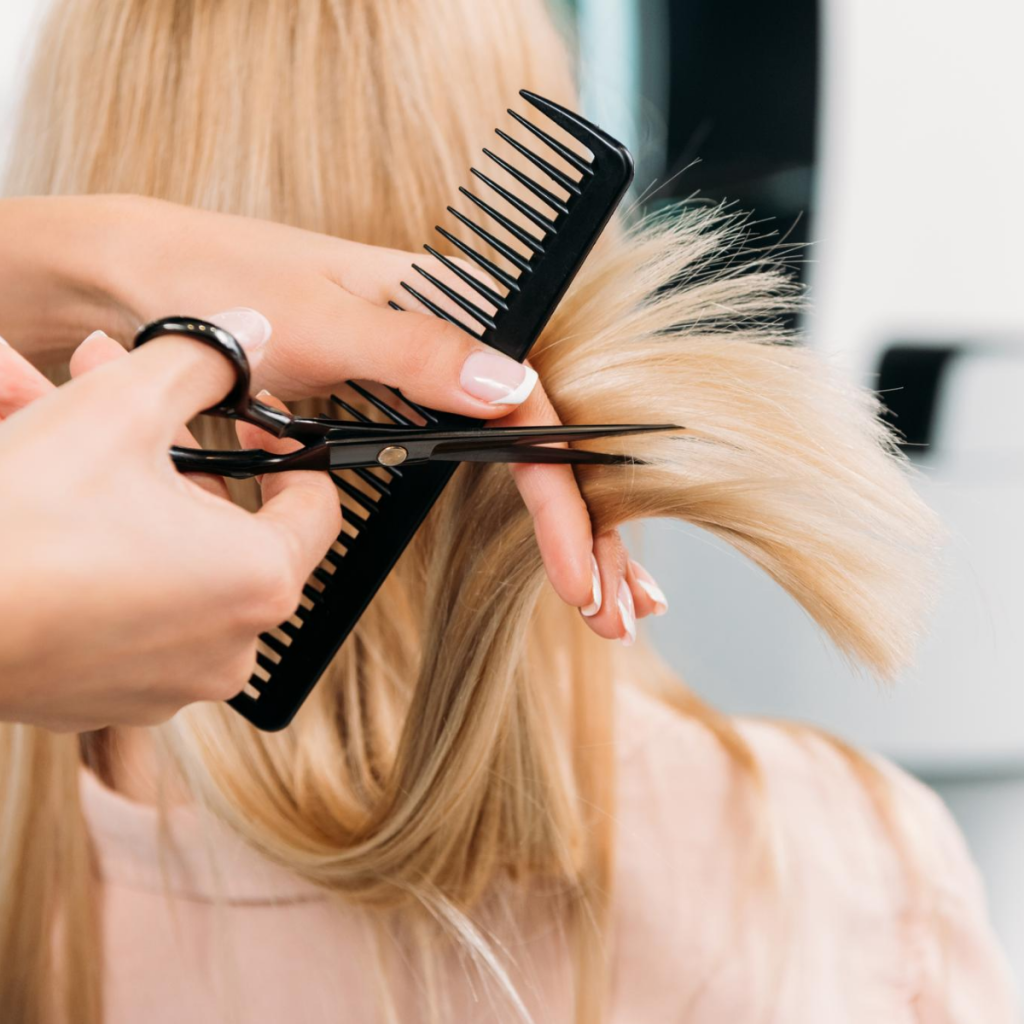Learn how to trim your hair at home with our recommended tools and techniques. Save time and money by mastering the art of DIY haircuts..
How to Trim Your Hair at Home: Tools and Techniques Recommended
Are you tired of waiting weeks for your next hair appointment? Do you want to save some cash while still looking fabulous? Well, look no further because we’re here to teach you how to trim your hair at home like a pro! In this guide, we’ll cover all the necessary tools and techniques you need to trim your hair with confidence. So, grab your scissors and let’s get started!

Understanding the Basics of Hair Trimming
Before diving into the world of DIY hair trimming, it’s crucial to understand why it’s essential and the terminology that comes with it. So sit back, get comfortable, and let’s uncover the secrets of hair trimming!
When it comes to hair care, trimming is an important step that should not be overlooked. Regular trims help maintain the health and appearance of your hair. They remove split ends, which can lead to breakage and make your hair look dull and frizzy. By trimming your hair, you promote healthy growth and maintain its overall vitality.
Now, let’s delve into the world of DIY hair trimming. Many people may feel apprehensive about cutting their own hair, but with the right knowledge and tools, it can be a rewarding experience. Not only does it save you time and money, but it also gives you better control over your hairstyle. You can customize your haircut to suit your preferences and experiment with different looks without breaking the bank!
Why Trim Your Hair at Home?
Trimming your own locks might sound daunting, but trust us when we say it’s all worth it. By taking matters into your own hands, you become the master of your own hair destiny. No longer will you have to rely on expensive salon visits or worry about scheduling appointments. With a few simple techniques and some practice, you can achieve professional-looking results from the comfort of your own home.
One of the main benefits of trimming your hair at home is the convenience it offers. Life can get busy, and finding time to visit a salon regularly may not always be feasible. By learning how to trim your own hair, you can save time and fit it into your own schedule. Whether it’s a quick touch-up or a complete style change, you have the flexibility to do it whenever you please.
Essential Hair Trimming Terminology
Before diving into the trimming process, it’s important to familiarize yourself with the hair trimming lingo. Understanding these terms will not only help you communicate your desired style but also enable you to achieve the perfect end result.
One essential term to know is “layers.” Layers refer to cutting the hair at different lengths, creating depth and dimension. Layers can add movement and texture to your hair, making it easier to style and giving it a more voluminous appearance.
Another important term is “feathering.” Feathering is a technique used to soften the ends of the hair, creating a more natural and blended look. It involves cutting small, wispy pieces of hair at an angle, resulting in a softer and more seamless transition between lengths.
Understanding these terms will give you the confidence to discuss your desired haircut with professionals or even try these techniques yourself. It’s always beneficial to have a clear understanding of the terminology to ensure effective communication and achieve the desired outcome.
Necessary Tools for Home Hair Trimming
Now that you’re convinced to embrace the world of DIY haircuts, let’s talk about the tools you’ll need. Don’t worry; you won’t require a fancy salon equipment setup. Just a few basic tools will do the trick!
When it comes to trimming your hair at home, a good pair of scissors is your best friend. Look for sharp, professional hairdressing scissors that will give you clean and precise cuts. Remember, your kitchen scissors won’t make the cut for this job!
But did you know that the type of scissors you choose can affect the outcome of your haircut? Different scissors have different blade types, such as straight blades, convex blades, and serrated blades. Each blade type has its own advantages and is suitable for specific cutting techniques. So, when selecting your scissors, consider the type of cut you want and choose the appropriate blade type accordingly.
While combs and brushes might seem interchangeable, they serve different purposes when it comes to trimming your hair. Combs are perfect for sectioning and detangling your hair, while brushes help you smooth out any knots and evenly distribute the hair for a more accurate trim.
There are various types of combs and brushes available in the market, each designed for different hair types and styling needs. For example, wide-toothed combs are ideal for detangling thick and curly hair, while fine-toothed combs work best for fine and straight hair. Similarly, paddle brushes are great for smoothing and straightening, whereas round brushes are perfect for adding volume and creating curls. So, choose the comb and brush that suits your hair type and desired hairstyle.
Don’t be left in the dark while trimming your hair! Good lighting is essential to ensure you can see every strand and make precise cuts. Make sure to position yourself near a window or use a well-lit room to prevent any unexpected surprises post-trim!
In addition to good lighting, having a mirror or two strategically placed can greatly assist you in achieving a professional-looking haircut. A full-length mirror will allow you to see your entire head from different angles, ensuring you don’t miss any uneven spots. A smaller handheld mirror can be used to check the back of your head and make sure everything looks balanced.
Furthermore, investing in a magnifying mirror can be a game-changer, especially if you’re aiming for intricate details or precise trims. The magnification will help you see the tiniest of hair strands and ensure you achieve the desired outcome.
Preparing Your Hair for Trimming
Before picking up those scissors, you’ll need to give your hair some tender loving care. Follow these steps to ensure your hair is in the best condition for trimming.
Trimming your hair can be an exciting way to refresh your look and get rid of split ends. However, it’s important to prepare your hair properly to achieve the best results. By taking the time to care for your hair before trimming, you’ll ensure that the process goes smoothly and your hair looks fabulous.
Washing and Conditioning Your Hair
Start off by washing and conditioning your hair with your favorite products. This step is crucial as it not only cleanses your hair but also makes it more manageable during the trimming process. Choose a shampoo and conditioner that are suitable for your hair type and gently massage them into your scalp. Rinse thoroughly to remove any product buildup.
After washing, it’s important to towel-dry your hair gently to avoid any breakage. Pat your hair dry instead of rubbing it vigorously with the towel. This will help to minimize friction and reduce the risk of damage. Remember, healthy hair is the key to a successful trim!
Detangling Your Hair Properly
No one wants to deal with a tangled mess while trimming their hair, right? To avoid any unnecessary frustration, it’s essential to detangle your locks properly before starting the trimming process.
Begin by using a wide-toothed comb to gently detangle your hair, starting from the ends and working your way up. This technique helps to prevent any further knots or tangles from forming. Be patient and take your time, especially if your hair is prone to tangling. Applying a leave-in conditioner or detangling spray can also make the process easier.
By detangling your hair beforehand, you’ll not only save time during the trimming process but also minimize the risk of accidentally cutting off more than intended. So, grab that comb and give your hair the attention it deserves!
Techniques for Trimming Different Hair Types
Now comes the exciting part – the actual trimming! We’ll guide you through the different techniques for trimming various hair types, ensuring you achieve the best results no matter what your tresses may be.
Trimming your own hair can be a rewarding and empowering experience. Not only does it save you time and money, but it also allows you to have full control over your hairstyle. Whether you have straight, curly, short, or long hair, there are specific techniques you can use to achieve a professional-looking trim.

Trimming Straight Hair
Straight hair is your canvas for a clean and polished look. To trim straight hair, start with small sections and trim off any split ends or breakage. Remember to take it slow and make small cuts to avoid any unforeseen hair disasters!
One useful tip for trimming straight hair is to invest in a pair of professional hair-cutting scissors. These scissors are specifically designed to give you clean and precise cuts, ensuring that your hair looks its best. Additionally, it’s important to have good lighting while trimming straight hair. Natural light or a well-lit room can help you see the hair strands clearly and make accurate cuts.
Trimming Curly Hair
Curly hair requires some extra love and attention. Embrace your natural curls and allow them to guide your trimming journey. Avoid straightening the hair before trimming, as it can lead to uneven cuts. Instead, separate your hair into curls or sections and trim carefully to maintain your desired shape.
When trimming curly hair, it’s crucial to work with dry hair. Wet hair tends to stretch, and once it dries, it may appear shorter than expected. By trimming your curls when they are dry, you can accurately assess the length and avoid any surprises. Additionally, using a wide-toothed comb or your fingers to detangle and separate your curls can make the trimming process easier and more manageable.
Trimming Short Hair
Short hair, don’t care! Trimming short hair can be a breeze with the right technique. Use your comb to lift sections of hair and trim the ends to maintain a well-groomed look. Remember to use your fingers as a guide to achieving the desired length.
For those with short hair, precision is key. You can consider using a razor comb or thinning shears to add texture and dimension to your hairstyle. These tools can help you achieve a more edgy or layered look, depending on your preference. It’s important to have a steady hand and take your time when trimming short hair to ensure symmetry and balance.
Trimming Long Hair
Long hair requires extra care and attention to maintain its health and length. Start by dividing your hair into manageable sections, then trim small amounts from the ends to remove any split ends or damage. By keeping your trims minimal, you can maintain your length while still achieving healthy and vibrant locks.
When trimming long hair, it’s important to invest in high-quality hair-cutting scissors. Dull or low-quality scissors can cause fraying or damage to the hair shaft, resulting in split ends. Additionally, regular deep conditioning treatments can help keep long hair strong and prevent breakage. Trimming long hair every 8-12 weeks can also promote healthy growth and prevent split ends from traveling up the hair shaft.
With these tips and tricks up your sleeve, you’re now ready to take on the world of DIY hair trimming! Remember, practice makes perfect, so don’t shy away from experimenting with different styles and techniques. Your hair, your rules!





